
12 Software Development Methodologies: When, Where and How to Use Them
From the early 1950s till the present, there are more and more different software development methodologies introduced within the tech industry.
In most cases, all those were firstly presented during the past decades, when a particular case required the use of a new development model that can fully meet the project’s characteristics, requirements, and goals. And, all the innovative approaches used were to make the development more productive and boost the desired results.

By the end of 2021, the IT spending on enterprise software is expected to reach over $600 billion worldwide, with a CAGR of 13.6% compared to 2020. As a substantial amount of these costs are invested in the software development branch, developers are now looking for the most optimized and effective methods of software creation.
Different types of software development methodologies can significantly eliminate the time, resources, and costs needed for the project realization. However, due to the vast number of these methodologies currently existing, it becomes more and more challenging to pick up the best model for each specific case.
In this article, Trident Technolab’s best experts will analyze all the available different software development methodologies within the industry, as well as define their strong sides and possible drawbacks so you could come up with the most beneficial yet efficient approach that ideally fits your project.
Let’s get it started!
What Is a Software Development Methodology?
To understand the types of development models existing, it’s important to learn the project development basics first.
The software development methodology refers to the development SDLC (software development life cycle) model, which is focused on organizing beneficial yet effective project development processes from the idea and planning to front-back & back-end development, testing, and software launching.
In other words, it is a so-called app development lifecycle that applies different formats, approaches, and techniques and helps to:
- Effectively organize the workflow
- Eliminate time for the project development
- Reduce the costs needed to develop a software
- Track the process of creation
- Provide a set of norms for the effective communication
- Improve the quality of the final product and more
Today, there are 12 standalone types of software development methodologies that introduce different models of project creating. However, each of those has its unique advantages and possible drawbacks, so it’s essential to analyze the core gist of your project as well as learn the pick up the most effective
As for 2021, one of the leading technological approaches practiced for software development is DevOps methodology, which is used in every third project (35.9%), says Statista.
But, in practice, it’s more efficient to review all the options available on the market and define which of the software development methodologies can fit your program best.
Types of Software Development Methodologies
As you already know, there are various types of different software development methodologies aimed at improving SDLC.
However, having reviewed them you can find out there’s no one outright winner – for each specific case, the strategy will be different based on the project’s characteristics, requirements, main goals, core features, and more.
Thus, the detailed comparison of software development methodologies can simplify the choice and help you to define the most winning option for each app development project individually.
#1. Agile Software Development Methodology
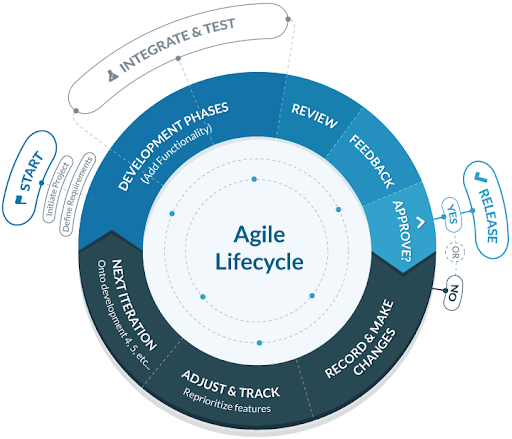
The main focus of this methodology is the project/product itself. That is why, it presupposes various constant alterations based on users’ and customers’ feedback, as well as internal changes related to the work of engineers.
The agile software development methodology is free of rigid frameworks on the one hand. While, on the other hand, the software development process is divided into short time boxes, thus offering the real results and feedback truly fast.
Major Benefits
- Problems are detected and fixed at the early stage
- Higher flexibility to the plan and easier adapting to different project changes
- Eliminated time of project deliverables
- Enhanced communication with the clients, and their close engagement to each stage of the software development process
- Top-notch quality of the final product
- Mostly fits smaller, young companies that are more flexible and open up for the active communication
Possible Drawbacks
- Lack of understanding the solution specifics before their implementation
- The high risks of ignoring the project documentation and requirements
- Insufficient predictability of the budgeting, marketing plans, sales, and more
- Requires immediate responding to issues and feedback in real-time
- Easy to get lost in details and be pulled off the project course
Source: https://blog.capterra.com
#2. Waterfall Development Methodology
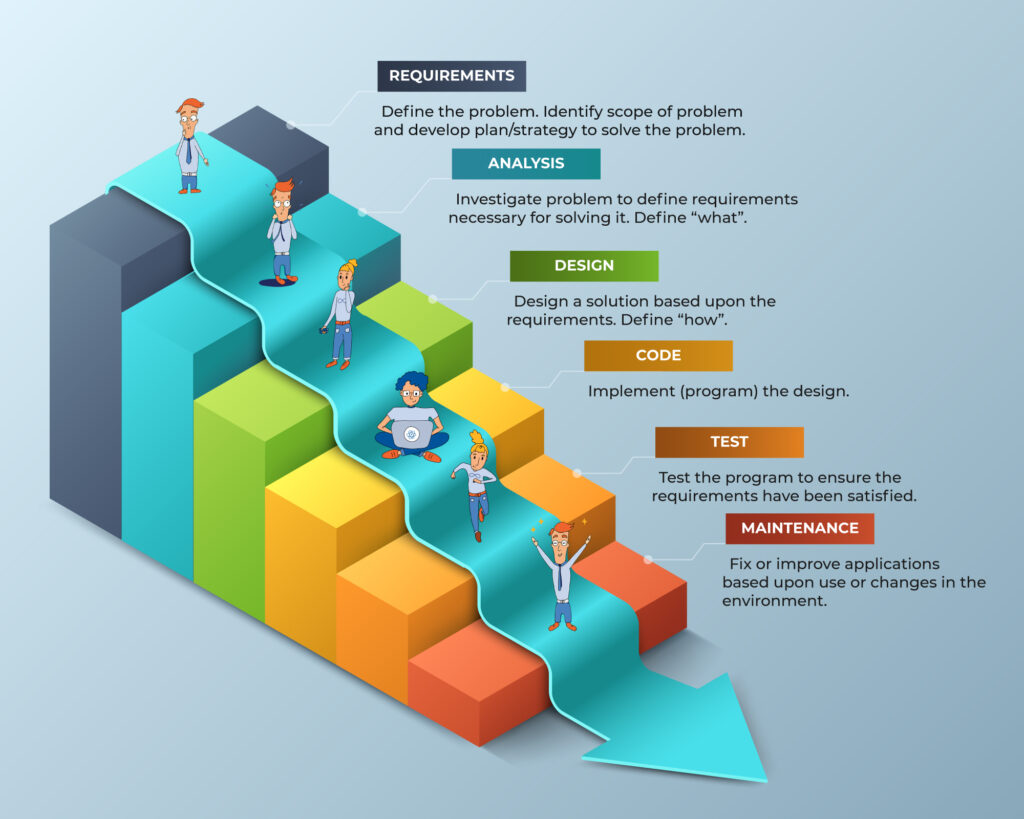
The absolute opposite to the previous approach, this methodology is strict and linear. A new stage can only be started if the previous one is completed. In other words, each phase gradually flows into the next one.
What is more, there is no going back to the previous stage. This approach is easy to understand as it presupposes a strict sequence of completed tasks. Waterfall software development methodology is often regarded as a classic representation of software development.
Major Benefits
- The project plan is simple and straightforward, with all the goals, requirements, and important aspects defined before the software development process
- All the processes are easy to understand
- Enforced discipline and better keeping the timelines
- All the steps of testing scenarios are planned in advance
- No financial risks due to the high planning accuracy
- The outcomes are easy to predict, as they meet all the requirements and criteria outlined in project documentation, so the companies get exactly what they were expected to develop
Possible Drawbacks
- The planning stage can be too challenging to organize the entire process
- Low flexibility and inability to implement the changes once the software development process is started
- The immediate changes to the project can result in additional spendings that are usually enormously high
- A longer time of delivery
- Weak for long or ongoing projects
Source: https://jelvix.com
#3. Extreme Programming Method
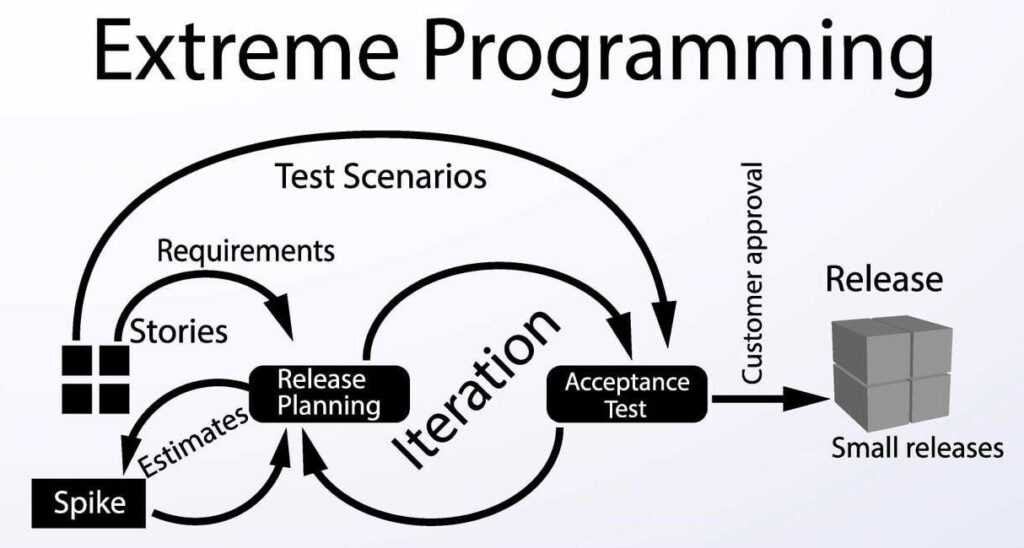
A perfect approach for unstable projects, as it implies involving the customer as much as possible. What is more, it presupposes considerable flexibility.
Extreme programming methodology is believed to boost the quality of software owing to its ability to adapt to dynamic changing demands. In addition to that, constant feedback and communication is the key to an efficient and happy team environment.
Major Benefits
- Significant customer involvement results in high-quality products
- Stable final product due to the continuous software testing
- Pair programming eliminates the errors that may occur during the software development process
- High level of flexibility and the ability to immediately implement the changes
- Code stays clear and comprehensive
- No rush to keep the timelines – developers work at their own pace
Possible Drawbacks
- Efficiency is much dependent on the people involved
- Vague and unknown future results
- Clients must always be engaged in the software development process
- Comparatively large time and high costs investments
- Is too challenging for the small teams, as they might not possess all the necessary skills and knowledge
Source: https://www.digite.com
#4. Lean Software Development
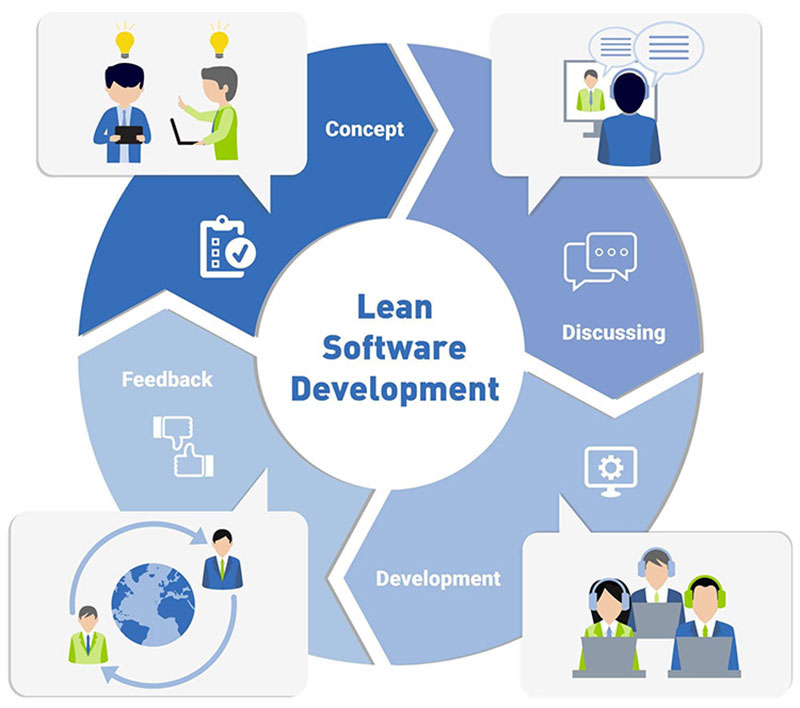
Value for the client is the essential core element the whole approach revolves around. If something is worth it, it should be done immediately; if not, it should be removed.
Lean software development methodology focuses a lot on loss reduction. That is why the whole project is examined significantly beforehand to eliminate any wasted time or money. As value is the core component, feedback plays a crucial role itself, so that the actions are taken fast.
Major Benefits
- Perfect for a low-budget project and rigid time limitations
- The team is focused on delivering the on-demand tasks
- Provides fast deliverability by eliminating the waste and useless processes
- Is easily scalable – ideally fits for large projects, unlike most of the other software development methodologies
- Cutting out tasks allows getting more time for the core processes and implementing the high-value features to the final product
- Enhanced teamwork enables focusing on meaningful and impactful work with a greater sense of purpose
Possible Drawbacks
- Success is much dependent on the working capacity of a team
- Low experience and lack of expertise might not work if the team works independently
- Cutting too many things can lead to a loss of project focus
- Risks of the delays due to certain bottlenecks or low resource levels
- Requires excellent documentation to ensure all the aspects are developed correctly
Source: https://lvivity.com
#5. Prototyping Methodology
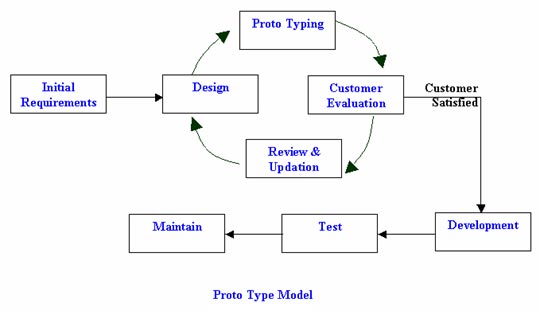
Based on the waterfall approach and having a significant focus on customer feedback. There are some initial requirements, developers provide samples, and only after customers evaluate the functionality of samples, the final development begins.
The gist of this software development methodology lies in the name itself – prototype methodology. In other words, before getting down to business, there will be painstaking research and prototyping to avoid unnecessary risks.
Major Benefits
- The prototype model can become a great information source for the UI/UX improvements
- Enhances the system functionality by analyzing the actual look and feel of the system being developed
- High involvement of clients and final consumers during the developing process
- Easier and more effective detection of errors and issues
- High flexibility of the app developing process, that enables adding the missing functions or redoing the existing ones
- Reduced time and costs due to the early detection of the critical issues
Possible Drawbacks
- Too much client involvement can affect the process by slowing it down
- Possible budget increase, as the management cost may go beyond the money limit
- Increased complexity system that can enlarge beyond the original plans
- Developers can reuse the existing prototypes that don’t always meet the client expectations instead of creating the new product from a scratch
- The risks of the development overdoing with too much effort, time, and costs invested
Source: https://padakuu.com
#6. Dynamic Systems Software Development Method
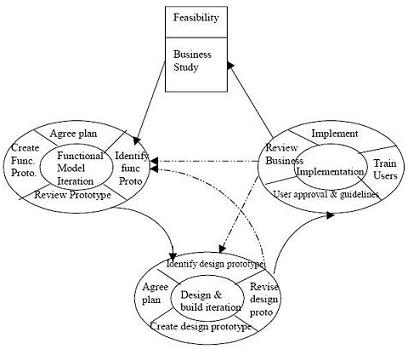
There are two main focuses: strict time frame and assigned budget. The idea is to manage to provide successful and effective software within a particular time limit and not exceed costs. Users’ involvement is of high importance as well. The dynamic systems model presupposes continuous feedback to deliver maximum functionality within the agreed requirements.
Major Benefits
- Time-boxed yet predictable project deliverability
- Developing processes are delivered at a standard level of quality, that can be improved through the analysis of documentation, software testing, and periodical reviewing of the outcomes
- Great communication between developers and clients
- Reaching the needed functionality as fast as possible
- Producing enough design work upfront (EDUF) to get a more concrete idea of what product client needs
- High control under each stage of the project development
Possible Drawbacks
- Requires considerable costs for development
- The approach will not fit and meet the needs of a small organization
- Doesn’t stimulate the developer creativity
- Projects are mainly focused on complying with the documentation and standards while can neglect some of the more sophisticated options available
- Requires an experienced team of developers with deep expertise in both business and technical aspects
Source: https://www.researchgate.net
#7. Feature Driven Development
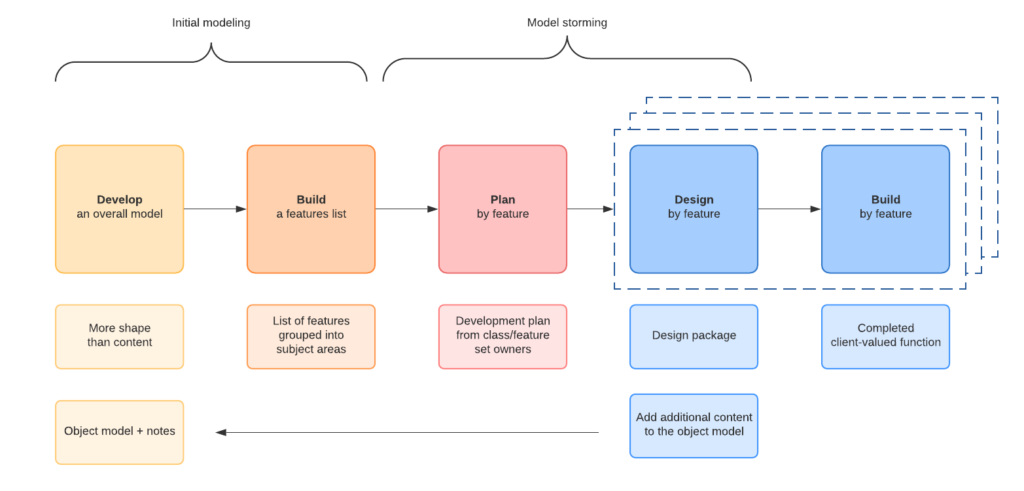
Features are regarded as a sort of user feedback. Planning, designing, and building are all feature-based. This approach involves iterations to boost functionality and deal with varied complexities. Feature driven development aims at organizing the work of a large number of teams within a big organization.
Major Benefits
- Mostly fits large-scalable, long-term, and ongoing projects
- Provides a detailed understanding of the project’s scope, major goals, and context
- Breaks the feature sets into smaller chunks and regular iterative releases, thus reducing the risks of errors and enabling delivering the specific features in shorter time frames
- Utilizes the pre-set standards to simplify the developing procedure
- Enables any developer with appropriate experience and expertise to handle the tasks
- Based on a user-centric approach, where the outcome depends on the user opinion
Possible Drawbacks
- Cannot be applied by small organizations and for smaller projects
- Requires several experienced developers to monitor the process
- Difficult to guarantee a strict deadline
- Doesn’t provide the written documentation for the clients, only the communication among the developers during the project launching cycle
- Is more focused on individual code ownership instead of the shared team model
Source: https://www.slideshare.net
#8. Rational Unified Process
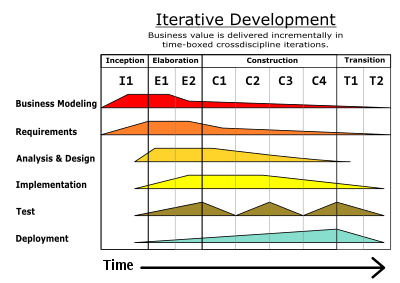
The idea of this approach lies in having four stages of the developing process. ‘During each of the phases, all six core development disciplines take place – business modeling, requirements, analysis and design, implementation, testing, and deployment’, according to study.com.
The main focus of this software development methodology is to craft an effective software of high quality without expanding the budget and missing the time frame.
Major Benefits
- Provides reliable, accurate, and strict documentation
- Eliminates the risks by taking into consideration the clients’ evolving needs
- Requires less time for integration when completing the software development life cycle
- The reuse of components allows reducing the time of project completion
- This development model can be studied through the online pieces of training and tutorials available on the Internet
- Incorporates the most effective practices of Waterfall by combining them into a more iterative process that is more flexible for changes
Possible Drawbacks
- Requires an expertized yet well-trained developer for this methodology to ensure the project success
- It May be too difficult to make the head or tail of the rational unified process model
- This development model doesn’t allow to reuse of the pre-made components
- Not effective for the big projects with multiple development systems, as it can cause more issues and confusion during the testing process
- The delivery process may be too time-consuming for certain types of projects
Source: https://alvinalexander.com
#9. Spiral Development Model
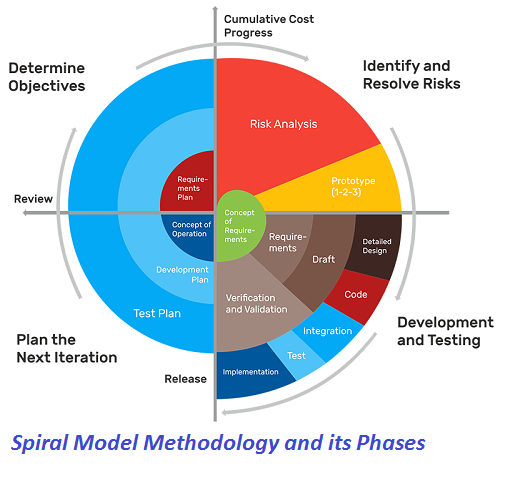
The main idea is to eliminate the risks at the early stage of the project. The developing procedure goes from smaller levels to the big ones gradually. This approach combines waterfall ideas with iterations.
Each stage involves setting the goals and receiving feedback from a client. Moving from one phase to another in a spiral model implies completing and removing the risks before moving forward.
Major Benefits
- Best fits to mission-critical and long-term projects which requires the professional risk analysis and thorough control
- The process of the estimation of the costs is pretty easy yet straightforward
- Features the fast achievement of the progress
- Repeated development helps to eliminate the possibility of risks and effectively control the system quality
- The specific functions or changes can be implemented at earlier and later stages
- Leaves a lot of improvement opportunities taken from the customer feedback
Possible Drawbacks
- Not suitable for small organizations and projects
- The danger of failing to meet the agreed budget and time limit
- Requires accurate following the spiral model project development protocol
- Demands a strict risk assessment expertise
- The correct risk analysis can be conducted by the expertise developers only
Source: https://techreceptives.com
#10. Joint Application Development
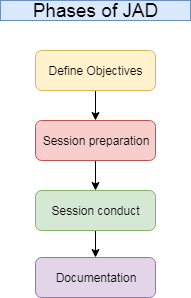
This approach implies significant interaction between users, designers, and developers. There are workshop sessions to facilitate and increase the developing process. During the session, the following people are involved: a facilitator, end-users, developers, observers, mediators, and experts.
What is more, in joint application development there is a considerable focus on eliminating errors at the early stage, thus saving the expenses needed to correct the mistakes later on.
Major Benefits
- Valuable information is achieved within a short period
- Immediate elimination of errors and resolving the differences, which greatly boosts the software quality
- Features accurate project requirements focused on improving the system quality
- Reduces the time and costs needed for the project development
- Enables close communication between the team members and client, which greatly speeds up the development process
- Allows team members to push each other for faster yet high-quality deliverables
Possible Drawbacks
- Can be quite a time and energy-consuming model when it comes to planning
- Requires significant budget for the project launching
- Needs highly experienced and expert professionals
- Depending on the project size, it can be more difficult to align goals and maintain the overall project picture
- The clients usually make a huge laundry list of demands with making them all “high-priority”
Source: https://backlog.com
#11. Scrum Development
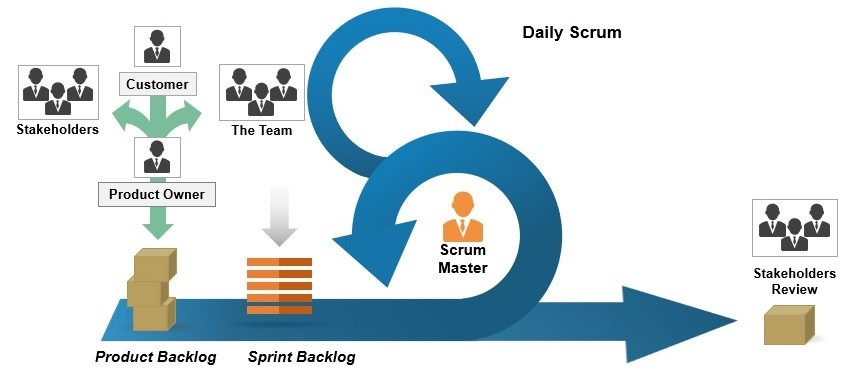
Easy to understand and effective when it comes to achieving results. The working process is divided into sprints. All the assignments for each sprint are set beforehand and are then discussed after this period.
Thanks to this approach, it is easy to get a response to emerging problems early, and as a result, solve them immediately. Scrum software development methodology is by far the most flexible. For this reason, it easily deals with projects having changing requirements.
Major Benefits
- All the stages and processes are clear and transparent
- Light control goes together with constant updating that keeps all of the team always on guard
- Removing the errors and project issues becomes much easier
- Implies high engagement of clients
- Enables frequent updates of the progress, which are proposed on the regular meetings
- Clients can trace the various project processes and measure the development performance
Possible Drawbacks
- The costs and time needed can often be uncertain
- No deadlines for the product delivery
- Big projects cannot be managed with this approach
- Only expert professionals that are constantly up to the tasks can be involved, with no beginners
- The test team must conduct regression testing after each sprint, which is one of the most notable difficulties of this methodology
Source: https://www.diegocalvo.es
#12. Rapid Application Development
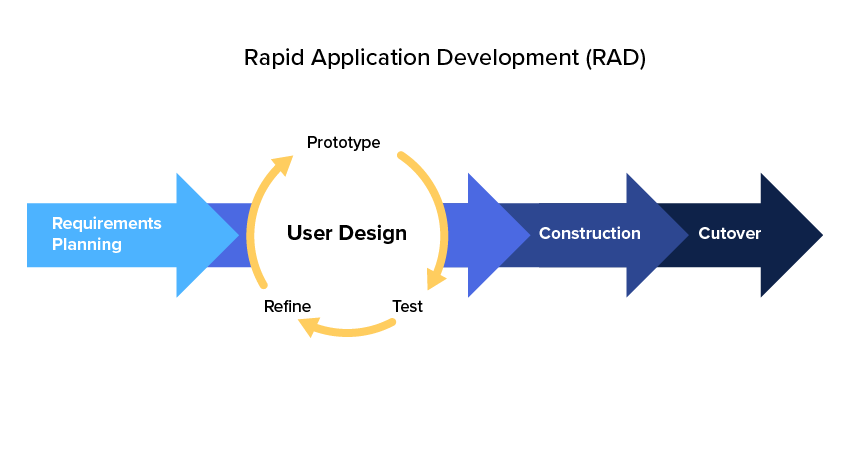
It is clear from its name that the main goal of this approach is to achieve fast results. To do so it uses the assistance of other development methodologies. It focuses on fast prototype releases and iterations.
As a result, quick feedback is received, errors are eliminated and the desired results are reached. It is as flexible and adaptable as possible. The main focus is to adjust so that the software is crafted functional and effective fast. Rapid application development methodology includes 5 stages: analysis and quick design, prototype cycles, testing, and implementation.
Major Benefits
- The client is encouraged to take fast reviews and constant feedback for the improvements
- Enables easy change of the core functions when the software is in the testing phase
- Minimizes the risks since the early stages of development
- Reduces the time of development by setting the deadlines for the project completion
- Is mainly focused on delivering the business problems important for the end-users
- Applies the use of automated tools that allows creating the prototypes easier and much quicker
Possible Drawbacks
- Not suitable for small projects
- Requires highly expert developers and a strong collaboration between the teams
- The stages are not strictly defined, which impacts the overall project structure
- The development costs are comparatively high
- All the requirements should be outlined before the development process starts
Source: https://kissflow.com
Why Should You Adhere to a Software Development Methodology?
Following the concrete software development methodologies can significantly impact the quality of your final product, its usability, and profits gained after the software release. Additionally, the most beneficial software methodology can impact the time and costs of the specific project development.
Having analyzed the detailed software development methodologies list, you can now have a more concrete idea of which models could fit your project best and deliver the high-quality yet feature-rich software product after implementation.
Whatever type of software methodology you’ll choose, you can always have a clear understanding of the project flow and provide the most effective updates in time.
Conclusion
As you can see, there are different types of software development methodologies, with each of those having its unique characteristics, valuable benefits, and possible drawbacks to be aware of.
Having learned the most important qualities of the development methods available on the software market today can not only eliminate the time, effort, and resources needed to get the project completed but also can radically improve the overall process of app creation.
Moreover, knowing the software methodologies list in detail can provide you with a better understanding of which of the models can be the most winning option for each specific software development project of yours!
At Trident Technolabs, we know how important it is to plan each stage of the project development to achieve the best product quality. That’s why our team of developers provides an individual approach to each client’s idea and dedicates lots of time to think over the slightest details that can improve the overall product performance.
We’ve got deep expertise in launching projects within different industries and are now ready to provide a variety of different services for delivering the best outcomes for each of our clients!
Do you already have the concept we can start working with?
Contact our team today to get a professional consultation regarding your project and discuss what benefits you can gain from day one!


Leave a comment: